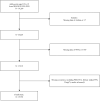Independent association of weight-adjusted waist index with asthma in U.S. adolescents: Mediating roles of eosinophil percentage, total cholesterol, and HDL cholesterol
- PMID: 40743247
- PMCID: PMC12312917
- DOI: 10.1371/journal.pone.0328796
Independent association of weight-adjusted waist index with asthma in U.S. adolescents: Mediating roles of eosinophil percentage, total cholesterol, and HDL cholesterol
Abstract
Background: Obesity is a risk factor for asthma in adolescents. "Although body mass index (BMI) is the most widely used metric for assessing obesity, it has several limitations. The weight-adjusted waist index (WWI) is a novel central obesity indicator and accurately reflects body composition. We aimed to explore the association of WWI with asthma in adolescents using NHANES 1999-2020 data.
Methods: WWI was calculated based on waist circumference (cm) divided by the square root of weight (kg). Current asthma status in adolescents was determined based on participants' self-reports. Multivariate logistic regression analysis, restricted cubic spline (RCS) analysis, mediation analysis, and stratified analysis were used to comprehensively explore this association.
Results: A total of 15,796 adolescents were included. In the fully adjusted model, WWI was positively associated with current asthma in adolescents (odds ratio 1.252, 95% confidence interval 1.125-1.392, p = 0.0001). Participants in the highest WWI quartile (Q4) showed a 54.5% higher prevalence of asthma compared to Q1 (p for trend = 0.0007).. RCS modeling indicated that the association was linear. Mediation analyses indicated that blood eosinophil percentage (EOS%), total cholesterol (TC), and high-density lipoprotein cholesterol (HDL-C) partially mediated this association by 9.89% (p < 0.0001), 7.47% (p = 0.048), and 8.24% (p = 0.044), respectively. This association was independent of BMI, and BMI also did not significantly interact with this association (p for interaction = 0.682).
Conclusions: WWI was linearly and positively associated with the prevalence of current asthma among U.S. adolescents, independently of BMI. EOS%, TC, and HDL-C partially mediated this association.
Copyright: © 2025 He et al. This is an open access article distributed under the terms of the Creative Commons Attribution License, which permits unrestricted use, distribution, and reproduction in any medium, provided the original author and source are credited.
Conflict of interest statement
The authors have declared that no competing interests exist.
Figures





Similar articles
-
The application and predictive value of the weight-adjusted-waist index in BC prevalence assessment: a comprehensive statistical and machine learning analysis using NHANES data.BMC Cancer. 2025 Jul 29;25(1):1234. doi: 10.1186/s12885-025-14651-6. BMC Cancer. 2025. PMID: 40730969 Free PMC article.
-
Weight-adjusted-waist index is positively associated with fecal incontinence: a cross-sectional study.J Health Popul Nutr. 2025 Aug 22;44(1):305. doi: 10.1186/s41043-025-01050-7. J Health Popul Nutr. 2025. PMID: 40847432 Free PMC article.
-
Association of weight-adjusted waist index and Albuminuria in children and adolescents: A national population-based study.PLoS One. 2025 Jul 23;20(7):e0324354. doi: 10.1371/journal.pone.0324354. eCollection 2025. PLoS One. 2025. PMID: 40700436 Free PMC article.
-
Gut microbiome-based interventions for the management of obesity in children and adolescents aged up to 19 years.Cochrane Database Syst Rev. 2025 Jul 10;7(7):CD015875. doi: 10.1002/14651858.CD015875. Cochrane Database Syst Rev. 2025. PMID: 40637175 Review.
-
Hormonal contraceptives for contraception in overweight or obese women.Cochrane Database Syst Rev. 2016 Aug 18;2016(8):CD008452. doi: 10.1002/14651858.CD008452.pub4. Cochrane Database Syst Rev. 2016. PMID: 27537097 Free PMC article.
References
MeSH terms
Substances
LinkOut - more resources
Full Text Sources
Medical

